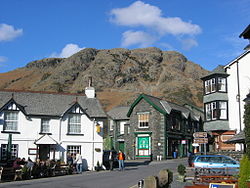Coniston: Difference between revisions
Created page with ':''Not to be confused with Coniston, Yorkshire'' {{Infobox town |name=Coniston |county=Lancashire |picture=Coniston.JPG |picture caption=<small>Coniston</small> |os grid ref=…' |
No edit summary |
||
| Line 1: | Line 1: | ||
{{Hatnote|Not to be confused with [[Coniston, Yorkshire]]}} | |||
{{Infobox town | {{Infobox town | ||
|name=Coniston | |name=Coniston | ||
Latest revision as of 17:44, 7 August 2014
| Coniston | |
| Lancashire | |
|---|---|
 Coniston | |
| Location | |
| Grid reference: | SD2996 |
| Location: | 54°22’5"N, 3°4’23"W |
| Data | |
| Population: | 1,058 (2001) |
| Post town: | Coniston |
| Postcode: | LA21 |
| Dialling code: | 015394 |
| Local Government | |
| Council: | Westmorland & Furness |
| Parliamentary constituency: |
Westmorland and Lonsdale |
Coniston is a village in Lancashire, in High Furness, beside the soaring Coniston Fells of the Lake District. It is found between Coniston Water, the third-longest lake in the Lake District, and Coniston Old Man, Lancashire's highest point, and about 18 miles northeast of Barrow-in-Furness.
The village lies within the Lake District National Park.
Name
The village's name is Old English; cyninges tun means "The king's estate" (or "village").
In much of Britain the same name has become Kingston through the later English cynges tun and it has been suggested that the -o- rather than -i- in the name marks a Scandinavian influence, from the Norse koningr ("king"). Ekwall[1] even speculated that this could have been the centre of a 'small Scandinavian mountain kingdom'. However an anecodate of Gerald of Wales from the days of Henry I show that cyning became cuning in some dialects, which may explain it in Coniston and its namesake in Yorkshire.
The village has given its name to its great lake, Coniston Water, and to Lancashire's greatest mountain, the Old Man of Coniston.
History
Coniston grew as both a farming village, and to serve local copper and slate mines. It grew in popularity as a tourist location during the Victorian era, thanks partially to the construction of a branch of the Furness Railway, which opened to passenger traffic in 1859 and terminated at Coniston railway station.
The poet and social critic John Ruskin also popularised the village, buying the mansion Brantwood on the Eastern side of Coniston Water in 1871. Before his death, he rejected the chance to be buried in Westminster Abbey, instead being laid to rest in the churchyard of St Andrews, Coniston. Ruskin Museum, established in 1901, is both a memorial to Ruskin and a local museum covering the history and heritage of Coniston Water and the Lake District.
The whole village was powered by hydroelectricity during the 1920s but this became so heavily taxed that the people there were forced to return to the national grid. Ironically, since 7 March 2007 a hydro-electric scheme has been in use to power up to 300 homes; being sited near the original.
The creation of the national park in the 1950s provided a further boost to tourism, with attractions such as the John Ruskin Museum and ferry services across the lake developing.
Donald Campbell added to the profile of the village and lake when he broke four World Water Speed Records on the lake in the 1950s. He died attempting to break the world water speed record for the eighth time in 1967, when his jet boat, "Bluebird K7", crashed at 252.0 knots (290.0 mph), having already set the record for the seventh time at Dumbleyung Lake, Western Australia in 1964. His body and boat (Bluebird K7) were discovered and recovered by divers in 2001 and he was buried in the new graveyard in Coniston in September 2001. A new wing has been built at the Ruskin Museum to accommodate the fully restored Bluebird K7 boat. It opened in late 2009 with the K7 due to arrive in late 2011 or early 2012.[2]
About the village
Coniston is a popular spot for hill-walking and rock-climbing; there are fine walks to be had on the nearby Furness Fells and Grizedale Forest, and some of the finest rock in the Lake District on the eastern face of Dow Crag, 3 miles from the village. The Grizedale Stages rally also takes place in Coniston, using the surrounding Grizedale and Broughton Moor (or Postlethwaite Allotment) forests.
The village is also home to a number of hotels and two Youth Hostels, one at the edge of the village, the other in the nearby Coppermines Valley.
Two slate quarries still operate at Coniston, one in Coppermines Valley, the other at Brossen Stone on the east side of the Coniston Old Man. Both work Coniston's volcanic slates, being blue at Low-Brandy Crag in Coppermines Valley, and light green at Brossen Stone (bursting stone).
Coniston is also an important local centre, with a Secondary School (John Ruskin School), Primary School (Coniston Church of England Primary School), bank, petrol station and other such services.
The scenery around Coniston derives from Coniston Limestone and rocks of the Borrowdale Volcanic Group.
It is also the location of the fictional Lawson Park vivisection research facility in the animated film of the Richard Adams' book The Plague Dogs from which the two dogs escape.
Pictures
-
St Andrew's Church
-
Yewdale Hotel
-
Black Bull
-
Church Beck
-
Farmstead near Coniston
-
Tarn Hows Cottage
-
View over Coniston Water
-
Yew Tree Farm and Tea Rooms
-
Shelter near Coniston
-
Village from Old Man
Outside links
| ("Wikimedia Commons" has material about Coniston) |
- Coniston at All Experts
- Coniston.uk.com
- Coniston Community Website
- Coniston Mountain Rescue Team
- Coniston Webcam - A view of Coniston village
References
- ↑ Ekwall, Eilert (1922). The place-names of Lancashire. Manchester: Chetham Society.
- ↑ http://www.ruskinmuseum.com/










